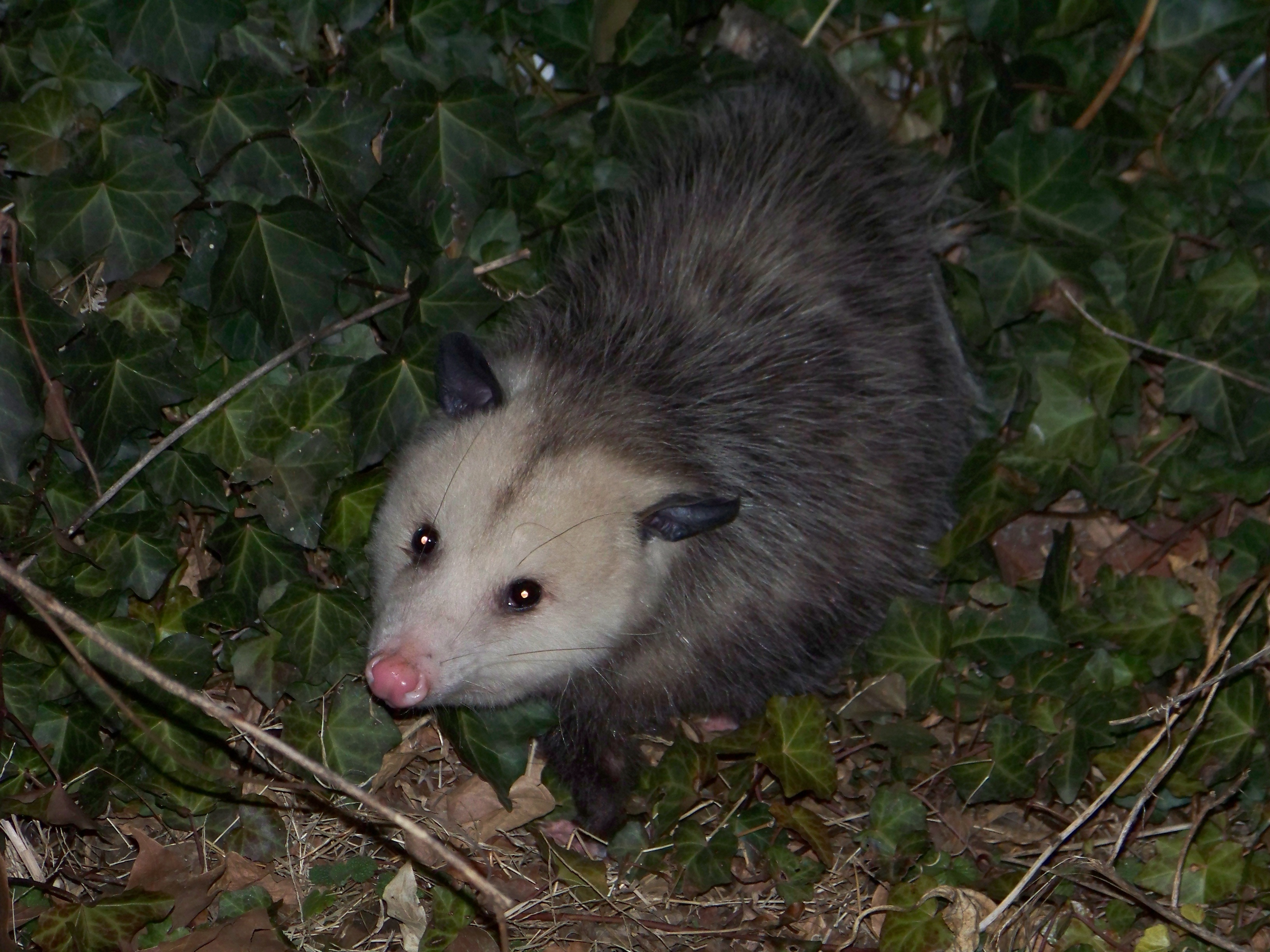They’re creepy-looking, really. They have a narrow, whiskery, tapering snout filled with fifty large, pointed teeth, and they drool. They also have a long, naked, scaly tail. People see that pointy face and naked tail and think rat. They’re not rats, though. They are opossums (Didelphis virginiana). Sometimes called “living fossils,” their history traces directly back some 65 million years and beyond, contemporary with dinosaurs. That’s probably why they look prehistoric—they are.
A pair of them wanders about near the house on Owl Acres, looking for water. They find a tiny puddle at the bottom of a downspout. It has been so dry that their usual water sources are gone. We put some water out in a dog dish. The next morning, the water is gone. The creatures of the night must all be thirsty.
These young opossums are each about the size of a cat, but the similarity stops there. The head is cone-shaped, ending in a point at a pink nose. It has little leathery black ears. Being nocturnal, it has a structure in the retina that enhances night vision. That makes its big, black popeyes glow a yellowish-green in a car’s headlights at night, when you’re most likely to see them. In spite of this enhancement, opossums don’t see very well and depend much more on their acute hearing and tactile input from their whiskers to assess the world around them. The fur is gray. It’s spikey and coarse, more like hair than fur and covers their stocky bodies and short legs. Opossums weigh between four and twelve pounds and are two to three feet long.
Each of the opossum’s front feet has five flexible toes with nonretractable nails. They use them in climbing and in catching, holding and manipulating food. The back feet have four toes and opposable “thumbs” rather like a human hand. They can grasp, hold and manipulate with these feet, climbing and carrying objects. They walk on the soles of their feet with the heel touching the ground, creating a characteristic waddle when they walk.
Those naked tails are prehensile. They use them for support when running or climbing, but also to wrap around and carry things like bundles of grass to line their nests with. They can also hang from their tails for short periods of time.
Like kangaroos, the opossum is a marsupial. Tiny newborn babies find their way into the mother’s pouch and latch onto nipples there. Up to a dozen young will stay connected in the pouch for about 90 days, and then they’ll drop off and emerge.
The opossum is the only marsupial mammal native to North America. Some 75 species of marsupials are native to Central and South America, and some 200 species inhabit Australia (including one called a “possum”). None is native to Europe or Asia, so everyone was amazed when one of Columbus’ captains brought one back to Spain in the 1500s. The opossum became a focus of study in scientific circles in Europe. In the 1600s, John Smith at Jamestown discovered opossums and wrote a description of them. He also gave them the name opossum, derived from the Algonquin word “apasam” meaning white animal.
The same adaptability that has kept them flourishing for millions of years has also helped them spread across North America. First noted in Virginia, they spread along with settlers, adapting to and thriving on the opportunities provided by people for food and shelter. Along with natural spread, in the early 1900s opossums were deliberately introduced on the west coast and in the western desert regions as fur-bearers or for sport hunting. They were also raised for food by people who moved to California from Tennessee and Kentucky. Today they range across most of the United States eating a variety of insects, earthworms, slugs, snails, crayfish, snakes and lizards, frogs, small rodents (primarily mice and rats), young rabbits, small birds, eggs, grasses, vegetables, fruits, berries, grains, human garbage, and carrion—basically anything they can get.
Opossums are generally not a threat to people. They don’t carry rabies, and are naturally very shy and nonaggressive. They would just as soon be left alone. If cornered, they will growl and open their mouths wide to show off all those teeth. If they’re frightened, they’ll play dead, sometimes up to several hours, lying motionless and hoping the predator will leave.
Because opossums are carrion eaters, they will endeavor to clean up roadkill on America’s highways. Unfortunately for the opossums, however, headlights seem to confuse them, and they don’t move very fast. So often they end up as roadkill themselves, and that is where most Americans will see them. On Owl Acres, they leave their peculiar little-hand footprints in new snow, and come out at dusk in search of supper.
Photo by: Wickedthought

2 comments
Opossums are carriers of EPM, a nasty disease in horses. Still, they are fascinating critters!
When our Scottie would bark incessantly at night, it meant that it had discovered an opossum. Because, of course, it was probably snarling. When we approached, it played dead. Your description of this useful creature enlightened our
appreciation for a creature that crawls our riverbank. Many thanks. Dietre McCormick